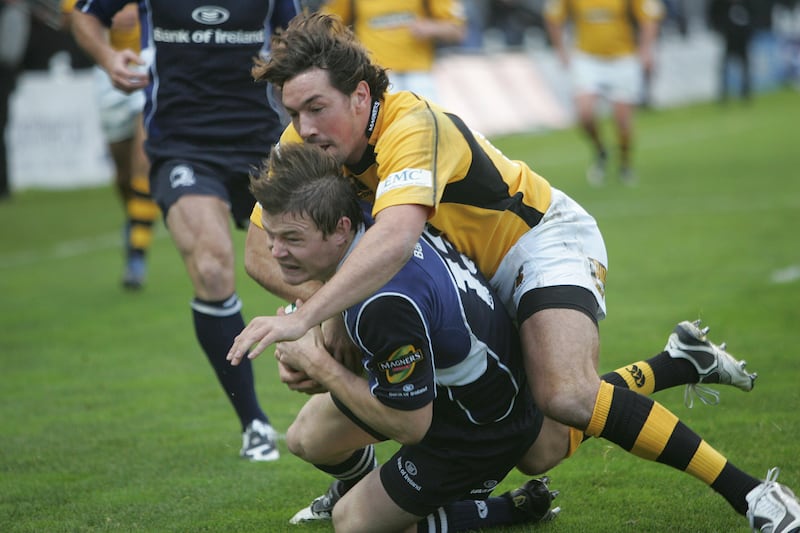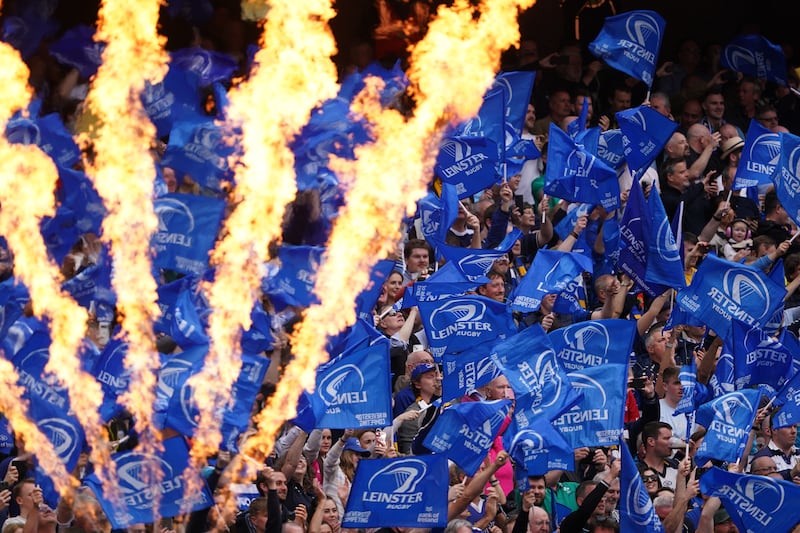Shane Nolan seems comfortable with change. The man who was in his playing days a rugby prop looks closer in stature these days to a full back. So maybe it shouldn’t have come as any great surprise when he made the leap from the senior executive ranks of the Irish business of search engine giant Google to the hot seat at Leinster Rugby.
To be fair, even Nolan admits the transition to his current job was not one he saw coming.
After close to 11 years at Google and committed for family reasons to staying in Ireland, he was on the lookout for a new role
“So, I had been having a little look around. But it was literally just a chance conversation with a friend of a friend, who said: ‘will you go and have a chat to somebody who is recruiting’,” Nolan recalls.
“I knew Mick [Dawson] was going but I didn’t think about myself being a candidate. But then I went to talk to a recruiter and I kind of thought, right, there is a commercial aspect to the role. All of my roles have been commercial. I have been into rugby all my life, and I am a season-ticket holder, all of that. I have been on boards of charities and so there is a lot of similarity with voluntary organisations and the Leinster set-up with the volunteer aspect and the committee aspect. The governance structure is quite similar.
“And all my work in Google over the last number of years there was with government liaison and relations, with government ministers and all the rest of it. There is a lot of that in this job and you start adding up and going ‘well actually there’s quite a fit here’.
“It was just perfect timing, a classic case of right place, right time.”
What he brings to the rugby side of the job is enthusiasm as a gifted amateur. He captained the senior team in his time at what is now University of Galway and represented Connacht U20s before playing for his local club, Navan RFC. He’s also a Leinster diehard, having been a season-ticket holder for a decade.
But the core of his role, as he sees it, is to maximise the commercial opportunity available to the club.
He was stepping into big shoes, he knew, following Dawson, who in his 21 years in the role had dragged Leinster from Portakabins in Donnybrook to state-of-the-art facilities in Clonskeagh. When he arrived, Leinster’s only silverware was from the interprovincial series; he departed leaving them as one of rugby’s most storied and successful clubs.
“Mick did unbelievable bringing it from nothing to where it is now. On the rugby side, the science and the excellence on the pitch is at a different level ... but I think there’s loads of room to grow on the commercial side,” Nolan says.
In his time, Dawson had multiplied the club’s income from €2 million to around €18 million. But then Covid struck. With ticket sales accounting for roughly half of all revenue, the club found itself in a pinch.
Success on the pitch, loyal fans, the steadfast support of the club’s 22 sponsors and a Government grant helped tide the club, rival provinces here and other Irish sports through the worst of the Covid crisis.
“Kudos to the Irish Government for putting their hand in their pockets to prop up Irish sport at a time of need,” Nolan says, contrasting it with the loans that clubs in England and Wales had to rely on.
“The English clubs were given a loan, which they have to pay back. We didn’t have to pay back the grant. That’s pretty significant, in fairness. We don’t have that hangover that the English clubs have. And we’ve seen what’s happened, there’s three of them have gone out of business in the last 18 months, so yeah, I think we’re doing all right from an Irish point of view.”

Revenue has recovered and sits closer to €19 million or €20 million, Nolan says. “and then we have IRFU funding on top of that as well”.
That may rise further this year as Leinster relocate to the Aviva and, for some high-profile matches, Croke Park as their RDS home undergoes an upgrade that will add 1,500 seats, bringing match day capacity to 20,000.
Filling those bigger number of seats is the first challenge for the new season.
He’s off to a good start. Season ticket sales are up about 30 per cent to 15,000. And as we sit down to talk just hours after tickets for Leinster’s URC clash with Munster on October at Croke Park went on sale last Friday, 45,000 of those tickets had already been snapped up, says Nolan, unable to repress a smile of satisfaction.
The tickets went on the market just 24 hours in advance of those for the Oasis reunion tour dates in Dublin and Nolan is very clear of what his competition is.
“Clearly we compete against our other rugby teams but actually we are in an entertainment business. You are competing with, like, Oasis going to sale tomorrow. If you go on to Ticketmaster now, the two big streams are Leinster/Munster and Oasis. Somebody’s going to make a decision. Do I put my hard-earned cash into this one or that one? So, for us, the challenge is how do we win on that one?
The next generation of supporters want a totally different experience. They want fireworks, they want cheerleaders, they want music, all of that
As of now, gate receipts bring in about half the club’s revenue, with sponsorship accounting for about 40 per cent. Nolan argues the two are interdependent – fuller stadiums attract sponsors who want to be involved. The balance come from all other activities – including merchandising, summer camps and ground rental.
“That scared the bejaysus out of me when I came in here first, because that looked like we need to diversify our revenue. And we do but not by reducing our gate revenue. We need to look after that while growing the other pies,” says Nolan.
In terms of how to get there, he sees potential in merchandising, which is still quite low in terms of financial contributions, as well as, in his words, “monetising our digital space”.
In all this, he remains aware that for all its international identity and success, rugby in general, and Leinster Rugby in particular, is not “big business” in corporate terms.
Leinster Rugby has a staff of about 200, with the professional game accounting for about 65 players with 30-odd back room staff, and between 60 and 66 per cent of the budget. “The point being,” Nolan says, “that I have more people out in clubs and schools building the grass roots of the game than I have players.”
“We’re not talking multibillion dollar businesses here. Big clubs have high brand profiles – for the bigger clubs, potentially the brand profile of a multinational – but they are run much more like SMEs,” he says, in the context of the pressure forever more games requiring ever bigger squads that have to be paid for.
Having said that, working for a business that is not required to deliver a profit for shareholders gives him a nice bit of freedom from the usual executive pressures of his previous commercial roles.
“We’re not in this to make money, right? We want to make money to reinvest in the game. It’s not a profit-driven entity here, but there is a science and there’s a commercial sharpness needed to get your pricing right, to get your product right and the fan experience being a good experience.”
Coming from Google, one of the things that surprised him was how little data information sporting clubs and organisations have on fans, particularly in rugby.
“All the things I’d love to do and be able to kind of tell you how many tickets we’d sell for this and what audience we have, actually it’s not quite there yet,” he says. “It will get there but it’s a journey, sport is definitely behind other businesses in terms of understanding the customer profiles and buying propensities, etc.”
While grateful for the loyal fan base Leinster has, Nolan is conscious of the need to keep attracting the next generation of supporters.
“They want a totally different experience. They want fireworks, they want cheerleaders, they want music, all of that,” he says. “So how do you make sure you absolutely look after your core customers, while knowing that you do need to bring more customers into the game, given they both want different things.”

Leinster’s success has brought with it a lot of sniping, particularly from across the Irish Sea but also from some supporters of other provinces, about the financial resources available to it. It is an issue that Nolan finds deeply irritating.
“I won’t lie to you, it’s frustrating when I hear that and it not being challenged because it’s just not true,” he says. “I’ve heard lines around Leinster being the most resourced club in the world. Any Google search will show you that, never mind the Japanese clubs because they’re on a different level, but the French clubs are all, you know, minimum 50 per cent more funded than any of the Irish clubs. That’s just fact.
“I think the Irish model has served Irish rugby well since it turned professional, in terms of managing our player resources, managing the size of the country and the size of our revenues, etc.”
IRFU funding amounts to somewhere between €50,000 and €110,000 for every senior squad professional men’s player – adding somewhere between €1.65 million and €3.6 million to Leinster’s coffers this year. But that’s not unique to Leinster. It is available to all the Irish provinces.
We can’t be the most successful rugby club in the world if we don’t have a brilliant, thriving women’s game
Looking back at last season, he notes that Leinster averaged attendances of 57,000 in the Champions Cup knockout games held in Dublin – against Leicester (the Aviva), La Rochelle (the Aviva) and Northampton (Croke Park).
“If you compare that to the English Premier League, we’d be in advance of Liverpool, we’d be in advance of Man City, we’d be fourth in the table [in terms of attendance],” he says. “But even adding that up, we’re still nowhere near French clubs or the Japanese clubs.”
Success has been elusive on the pitch for Leinster in recent seasons.
“It’s hard to get to the finals,” Nolan says, “and we’re getting to them consistently like no other team in Europe ... it’s so hurtful that we’re not crossing the line. It just feels a bit raw at the moment, because we’ve had very recent experience of coming agonisingly short.”
But it is not the only way that Nolan measures success. Winning is always good but, he argues, more important is “consistently reaching finals year after year after year. Which we are. Are we producing home grown talent or players? We are. Between 85 per cent and 95 per cent of our players come through Leinster schools and clubs. Are we growing the game? Are we filling our stadium? Are we driving the commercial money that can be reinvested in the game? So, success is lots of different things.”
It’s early days yet for Nolan in his role but what would he like to leave behind as a legacy?
“Well, I want us to be the most successful club in the world. I think we’re one of them. I want us to be the one.”
He’s not talking just about success on the pitch. He has a revenue target in mind for the next three to five years that he is determined to hit. “As an old boss of mine in Google said ‘revenue solves all known problems’. If you can grow your revenue, you give yourself your freedom to do lots of things you want to do.”
That includes growing Leinster’s brand beyond the 12 counties in the province. The expat community in London is currently its next biggest area of support but the club already has “a few early-stage kind of things on the ground going in America” in advance of the men’s Rugby World Cup in 2031 and the Women’s World Cup in 2033. It’s early days yet but Nolan is clearly excited by the potential.
The women’s game is, he says, probably where the biggest opportunity is for the sport as a whole, especially in terms of growing the audience.
“We can’t be the most successful rugby club in the world if we don’t have a brilliant, thriving women’s game. I think we’re early in our journey, but I’m putting a lot of time and attention and effort into it. I think we’ve had a chequered history in that one in this game but we are where we are, let’s go and drive it.”
But before all those, his top priority is managing the transition out of the RDS to the Aviva and back again “smoothly and seamlessly and to a point where we’re getting to Leinster being the hottest show in town”.
***
CV
Name: Shane Nolan
Age: 52
Position: Chief executive, Leinster Rugby
Family: Married to Clare, they have three daughters, Izzy, Katie and Freya.
Outside interests: A self-confessed sports nut, he’s a keen runner, having run numerous marathons, ultras and triathlons. Coming up are two marathons in three days in December – one in Chile and one at the South Pole. He also plays football and golf and treasures time with family and friends.
Something that you would expect? Having come from Google, an interest in developing the data side of rugby and its audience to help grow its commercial potential is high on his agenda.
Something that might surprise? Rugby may be the day job but he coaches GAA at Ranelagh Gaels, where his daughters play.
- Sign up for Business push alerts and have the best news, analysis and comment delivered directly to your phone
- Find The Irish Times on WhatsApp and stay up to date
- Our Inside Business podcast is published weekly – Find the latest episode here




















